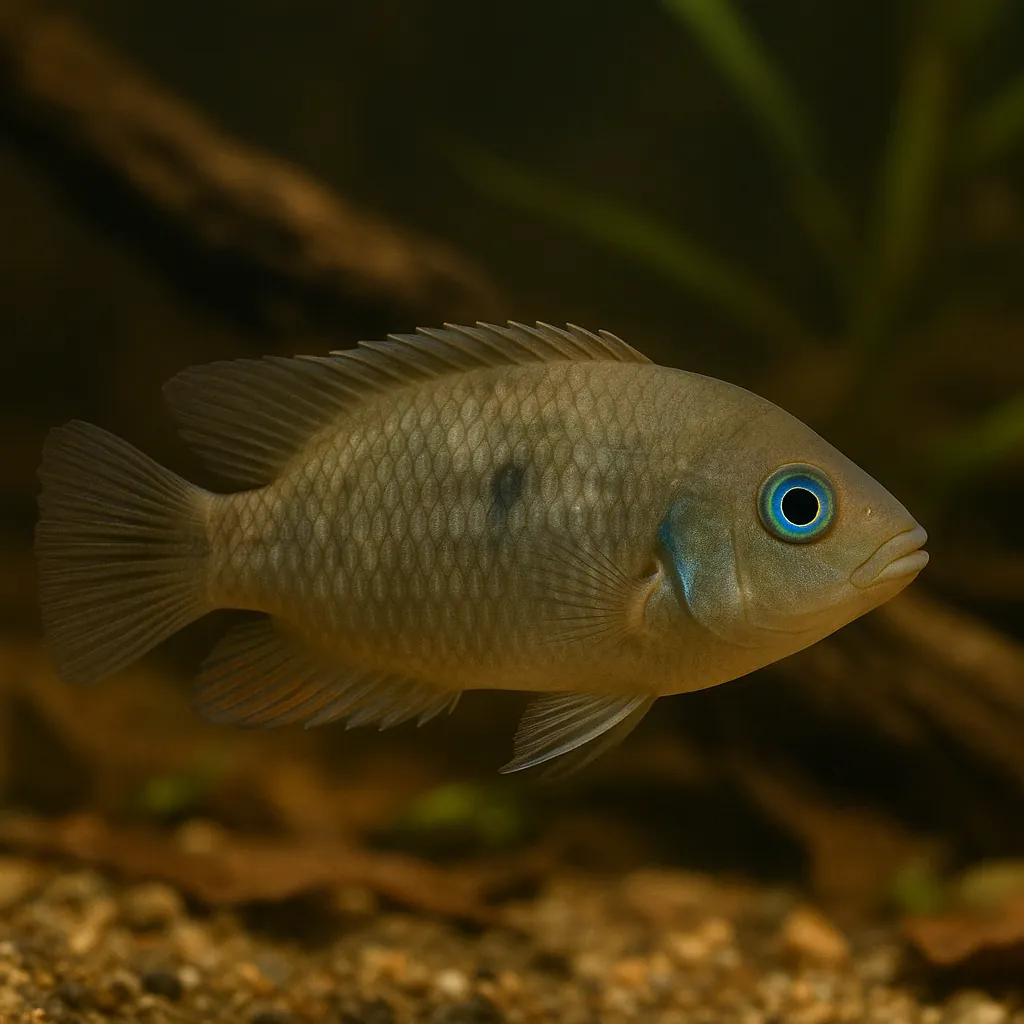
Blue-eye cichlid
Introduction
The Blue-eye cichlid (Cryptoheros spilurus) is a captivating freshwater fish native to Central America. Renowned for its striking blue eyes and vibrant coloration, this species has become a favorite among aquarists. Its manageable size and relatively straightforward care requirements make it an excellent choice for both novice and intermediate fishkeepers.
What makes the Blue-eye cichlid appealing to aquarists?
Its vivid blue eyes and dynamic behavior add a unique charm to home aquariums, providing both visual appeal and engaging interactions.
Is the Blue-eye cichlid suitable for beginners?
Yes, with proper research and commitment to maintaining appropriate tank conditions, beginners can successfully keep Blue-eye cichlids.
Care and Environment
Providing optimal care for the Blue-eye cichlid involves attention to tank setup, water parameters, diet, and understanding their behavior.
What is the minimum tank size for a Blue-eye cichlid?
A minimum of 100 liters is recommended for a single pair to ensure adequate space and reduce territorial disputes.
What are the ideal water parameters for Blue-eye cichlids?
Maintain a temperature between 24°C and 28°C, a pH of 6.5 to 7.5, and water hardness ranging from 10 to 30 dGH to replicate their natural habitat.
How should the tank be decorated for Blue-eye cichlids?
Incorporate rocks, caves, and driftwood to provide hiding spots and territories, mimicking their natural environment and reducing stress.
What is the recommended diet for Blue-eye cichlids?
As omnivores, they thrive on a varied diet of high-quality cichlid pellets, supplemented with live or frozen foods like brine shrimp and bloodworms.
Are Blue-eye cichlids aggressive?
They can exhibit territorial behavior, especially during breeding. Providing ample space and hiding spots can help mitigate aggression.
Origin and Habitat
Native to the Atlantic slopes of Central America, including countries like Belize, Guatemala, Honduras, and Nicaragua, Blue-eye cichlids inhabit lakes and rivers. They prefer shallow waters with sand, mud, or rock substrates and are commonly found in slower-moving sections of lower river valleys.
What type of environments do Blue-eye cichlids prefer in the wild?
They favor shallow, slow-moving waters with sandy or muddy bottoms, often near riverbanks.
Do Blue-eye cichlids experience seasonal changes in their habitat?
While specific seasonal behaviors are not well-documented, they are adapted to environments with varying water conditions.
Temperament and Compatibility
Blue-eye cichlids are generally peaceful but can become territorial, especially during breeding. They are best kept with similarly sized, non-aggressive fish. Suitable tank mates include other medium-sized Central American cichlids, larger tetras, and catfish. Avoid housing them with smaller, more passive species that may be intimidated or outcompeted.
Can Blue-eye cichlids be kept in a community tank?
Yes, with careful selection of compatible tank mates and adequate space, they can coexist peacefully in a community setting.
How can aggression be minimized in a tank with Blue-eye cichlids?
Providing ample hiding spots, maintaining appropriate tank sizes, and monitoring interactions can help reduce aggression.
Interesting Facts
Blue-eye cichlids are known for their strong parental instincts. During breeding, both parents actively guard and care for their offspring, often laying eggs in sand depressions and producing 300-400 fry per spawning. Their adaptability to various environments has contributed to their popularity in the aquarium trade.
How long do Blue-eye cichlids typically live?
With proper care, they can live up to 10 years, providing long-term enjoyment for aquarists.
Are Blue-eye cichlids prone to any specific health issues?
They are generally hardy but can be susceptible to common freshwater fish diseases if water quality is not maintained.
Sources
All information in this article has been gathered from the following reputable sources:
Overview
Recommended Tank Size 39.6 Gallons (for a pair) |
Minimum Group Size 2 |
Minimum Tank Volume 26.4 Gallons |
Maximum Adult Length 4.7 inches |
Average Adult Length 3.9 inches |
Shoaling (6+ required) No |
Preferred Water Type Freshwater, neutral to slightly acidic |
Temperature Range (°C) 24–28 |
pH Range 6.5–7.5 |
Water Hardness (dGH) 10–30 |
Typical Lifespan (years) 10 years |